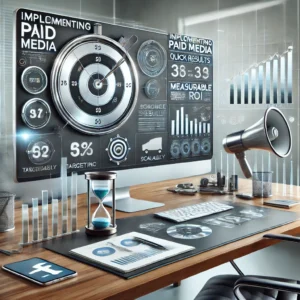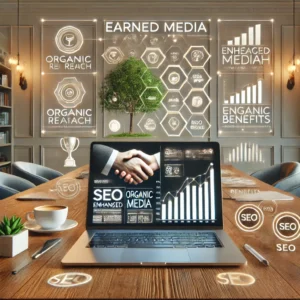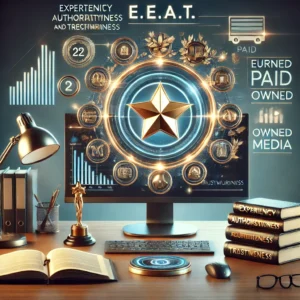Harness the Unique Advantages of Diverse Media Types to Elevate Your Marketing Strategy
As the realm of public relations (PR) and media marketing continues to transform, marketing leaders are exploring the distinctive advantages that earned media provides in contrast to paid media. Each media category plays a crucial role in developing a robust media strategy. With the approach of 2025, the integration of these media types—alongside owned and shared media—is vital for enhancing outreach, fostering trust with target audiences, and promoting sustainable growth for any marketing initiative.
Expand Your Brand’s Influence Using Targeted Paid Media Strategies
Exploring Paid Media: Practical Uses and Valuable Insights
Paid media involves various advertising techniques that require financial investment for ad placements. This strategy acts as a direct channel to boost your brand visibility and expand your reach across multiple advertising platforms. Key examples of paid media include:
- Digital Ads: This includes banner ads, display ads, and video ads strategically positioned on websites and mobile applications, effectively grabbing your target audience’s attention and directing traffic toward your offerings.
- Fan Acquisition: Techniques that focus on increasing your follower base across various social media platforms, cultivating a larger and more engaged community around your brand.
- Boosted Content: Amplifying the visibility and reach of existing content by promoting it to a wider audience, thereby enhancing engagement and interaction with your brand.
- Native Advertising: Crafting ads that blend seamlessly with the platform’s organic content, delivering a smooth and non-disruptive user experience while promoting your brand.
- Content Syndication: Distributing your content across multiple third-party websites to maximize exposure and engage with new audiences effectively.
- Sponsored Content: Collaborating with publishers to create engaging promotional articles or posts that effectively highlight your brand’s offerings while providing value to readers.
- Content Distribution: Utilizing paid channels to ensure your content effectively reaches your target audience, enhancing the chances of conversions and customer engagement.
- Pay to Play: Investing in specific media placements to gain visibility in preferred channels, ensuring your message reaches the right audiences effectively.
- Media Relations: Cultivating relationships with media outlets to create paid opportunities for enhanced visibility and interaction with your target demographics.
- Influencer Marketing and Shout-Outs: Compensating influencers to authentically promote your brand and engage with their audience, thereby expanding your reach.
- Experiential Marketing: Designing immersive experiences that captivate potential customers, creating memorable brand interactions that foster loyalty.
- Marcomm: Encompassing a range of marketing communications strategies that integrate paid media to optimize outreach and improve overall campaign performance.
 Key Benefits of Incorporating Paid Media into Your Marketing Strategy
Key Benefits of Incorporating Paid Media into Your Marketing Strategy
<pIntegrating paid media into your marketing strategy offers numerous advantages that are essential for effective contemporary campaigns:
- Immediate Results: Unlike organic marketing strategies, which may take time to yield results, paid media provides quick visibility and significant traffic increases almost instantly, facilitating timely campaign adjustments.
- Targeted Reach: With advanced targeting options, you can directly connect with specific demographics, interests, and behaviors that align with your ideal customer profile, enhancing campaign efficiency.
- Scalability: Paid media campaigns can be easily adjusted and scaled based on your budget and specific objectives, providing the flexibility to adapt and optimize as needed.
- Measurable ROI: By utilizing analytics tools, you can accurately evaluate your performance and return on investment, enabling effective assessment of your campaigns’ success and areas for improvement.
- Control Over Messaging: Paid media grants comprehensive control over the content and presentation of your advertisements, ensuring they align with your brand’s core values and messaging for maximum impact.
Implementing Proven Paid Media Strategies for Enhanced Results
To fully leverage the benefits of paid media, consider adopting these impactful strategies to drive superior outcomes:
- Utilize Programmatic Advertising: Automate your advertising purchases to effectively target specific audiences on a broader scale, enhancing efficiency, and improving reach.
- Leverage Social Media Ads: Platforms such as Facebook, Instagram, LinkedIn, and Twitter provide diverse advertising options to engage various audience segments effectively and meaningfully.
- Invest in Search Engine Marketing (SEM): Utilize Google Ads and similar platforms to attract traffic driven by user intent and search behavior, enhancing your online visibility and engagement.
- Experiment with Video Advertising: Captivate audiences with engaging video content on platforms like YouTube and TikTok, driving interaction and significantly boosting brand awareness.
- Optimize for Mobile: Ensure that your paid media campaigns are mobile-optimized, as a substantial portion of digital traffic originates from mobile devices, enhancing user experience.
- A/B Testing: Continuously experiment with various ad creatives, copy variations, and targeting strategies to improve the overall performance of your campaigns, driving better results.
- Retargeting Campaigns: Re-engage users who have previously interacted with your brand to enhance conversion rates and cultivate long-term customer loyalty.
Exploring the Essential Role of Earned Media in Contemporary Marketing
Understanding Earned Media: Definition and Impact
Earned media represents the visibility and publicity obtained through unpaid efforts, encompassing all organic coverage received by your brand. This type of media significantly enhances your credibility and authority within your industry. Historically, earned media primarily focused on mentions in journalistic outlets and blogs. However, as we move into 2024, the landscape has adapted to embrace a multitude of digital interactions, broadening the definition and potential of earned media.
 Significant Advantages of Earned Media for Your Brand
Significant Advantages of Earned Media for Your Brand
The advantages of earned media are extensive, especially in building long-term trust and establishing authority within your market:
- Credibility and Trust: Earned media is often perceived as more trustworthy since it is not directly financed, enhancing consumer trust in your brand and its offerings.
- Organic Reach: This media type can lead to viral sharing, facilitating organic growth without the need for ongoing financial investments in advertising.
- SEO Benefits: Acquiring high-quality backlinks from reputable sources can significantly boost your website’s search engine rankings and overall visibility, driving more traffic.
- Long-Lasting Impact: The effects of earned media can persist well beyond the initial coverage, providing enduring benefits for your brand and reinforcing its reputation.
- Improved Brand Reputation: Positive reviews and word-of-mouth referrals can greatly enhance your brand’s reputation among consumers, influencing their purchasing decisions.
Effective Strategies to Maximize the Benefits of Earned Media
To successfully tap into the vast potential of earned media, consider implementing these effective strategies:
- Public Relations (PR): Establish strong relationships with journalists and media outlets to secure valuable coverage and enhance your brand’s visibility.
- Content Marketing: Produce high-quality, shareable content that attracts mentions and backlinks from other authoritative sources, amplifying your brand’s reach.
- Influencer Relations: Collaborate with key influencers who can authentically promote your brand to their followers, broadening your audience.
- Social Media Engagement: Actively participate in discussions on platforms like Twitter (now X) and Reddit to increase your brand’s visibility and credibility.
- Encourage Reviews and Testimonials: Promote positive user reviews on platforms such as Yelp, Google Reviews, and industry-specific sites to build trust and enhance reputation.
- Referral Programs: Create structured programs to incentivize existing customers to refer new clients to your business, fostering growth.
- Link Building: Implement strategies to secure high-quality backlinks from authoritative websites, boosting your SEO efforts and online presence.
- Participate in Industry Events: Gain visibility by sponsoring or contributing to relevant industry events and webinars, positioning your brand as a thought leader.
Unlocking Marketing Potential Through Owned and Shared Media
The Crucial Role of Owned Media in Your Marketing Strategy
Owned media refers to the marketing channels that your brand controls, including your website, blog, email newsletters, and social media profiles. These platforms are essential for establishing a consistent brand voice and delivering high-value content tailored to your audience’s needs.
Key Elements of Owned Media Include:
- Website: Acting as the central hub for your digital presence, it should offer comprehensive information about your products and services, guiding potential customers through their journey.
- Blog: A platform for sharing insights, updates, and valuable content aimed at attracting and engaging your target audience effectively and meaningfully.
- Email Marketing: Facilitates direct communication with your audience, promoting lead nurturing and relationship-building while delivering personalized content.
- Social Media Profiles: Channels for engaging with your audience, sharing content, and effectively promoting your brand across various platforms.
Strategic Approaches to Maximize Shared Media
Shared media includes content that is distributed across social networks and other platforms, often created by users or fans. This encompasses user-generated content (UGC), shares, likes, and comments that organically extend your brand’s visibility and reach within the community.
Effective Strategies for Enhancing Shared Media Include:
- Encourage UGC: Motivate your audience to create and share content related to your brand through engaging contests and campaigns that inspire creativity and participation.
- Foster Community Engagement: Build a vibrant community by actively participating in conversations across various social media platforms, enhancing brand loyalty and trust.
- Leverage Social Sharing Tools: Integrate social sharing buttons on your website and blog to facilitate easy content sharing for users, amplifying your brand’s reach.
- Collaborate with Influencers: Partner with influencers to expand your reach by tapping into their established audiences and networks, driving engagement and interest.
- Monitor and Respond: Keep track of shared mentions and respond promptly to maintain a positive brand image, enhancing user engagement and satisfaction.
 Understanding the Importance of E.E.A.T. in Your Media Strategy
Understanding the Importance of E.E.A.T. in Your Media Strategy
Defining E.E.A.T. and Its Relevance in Marketing
E.E.A.T. stands for Expertise, Authoritativeness, and Trustworthiness. This principle is essential in the fields of SEO and digital marketing, significantly influencing how search engines evaluate and rank your content. Cultivating a strong E.E.A.T. profile can greatly enhance your online visibility and boost consumer credibility in your offerings.
Enhancing E.E.A.T. Through Integrated Media Approaches
By combining earned, paid, owned, and shared media, you can significantly improve your E.E.A.T. using the following strategies:
- Showcase Expertise: Utilize your owned media platforms to publish high-quality, informative content that demonstrates your skills and knowledge in your field, establishing your brand as a thought leader.
- Establish Authoritativeness: Secure earned media coverage from reputable sources and endorsements from influencers to position your brand as a leading authority within its industry.
- Build Trustworthiness: Consistent and transparent communication across all media types fosters trust and reliability with your audience and stakeholders alike.
- Generate Backlinks: Efforts in earned media, such as PR outreach and partnerships with influencers, can lead to valuable backlinks that boost your site’s SEO performance.
- Engage with Your Audience: Active interactions through shared media—such as responding to comments and participating in discussions—enhance your brand’s reliability and trustworthiness among consumers.
Creating a Comprehensive Media Strategy That Integrates All Four Media Types
Effective Techniques for a Unified Media Approach
To fully leverage the potential of your media efforts, it’s essential to unify earned, paid, owned, and shared media into a cohesive strategy. Here are some effective techniques to achieve this:
- Define Clear Objectives: Establish specific goals for each media type, whether it is increasing reach, enhancing credibility, or driving conversions, to tailor your strategy effectively.
- Align Content Across Channels: To create a coherent brand presence, ensure consistency in messaging and branding across all media platforms, reinforcing your value proposition.
- Leverage Synergies: Utilize paid media to amplify your earned media efforts, such as promoting favorable PR stories through targeted digital advertising for maximum visibility.
- Monitor and Analyze Performance: Employ analytics tools to assess the effectiveness of each media type, allowing for strategic adjustments based on real-time performance insights.
- Adapt to Trends: Stay informed about the latest media trends and technologies to maintain a relevant, competitive, and effective strategy that resonates with your audience.
Case Studies Showcasing Success Through Media Integration
Case Study 1: Tech Innovators Inc.
Tech Innovators Inc. successfully merged earned and paid media to launch a groundbreaking product. They utilized paid digital advertisements to generate excitement and drive traffic to their website while engaging in PR efforts to secure features in leading technology publications, significantly boosting their credibility. By leveraging social media sharing and collaborating with influencers, they created a viral effect that greatly enhanced their brand authority and sales performance.
Case Study 2: EcoFriendly Solutions
EcoFriendly Solutions effectively educated its audience on sustainability by combining content marketing (owned media) with sponsored content (paid media). Their initiatives in earned media, including features in environmental blogs and active participation in industry discussions, positioned them as leaders in their niche. The integration of shared media through user-generated content campaigns further amplified their messaging, fostering customer trust and long-term loyalty.
 Key Trends Shaping the Future of Media Marketing in 2025
Key Trends Shaping the Future of Media Marketing in 2025
As we progress through 2025, several crucial trends are influencing the future of media marketing:
- AI-Driven Personalization: Employing artificial intelligence to craft highly personalized advertising and content experiences tailored to individual user preferences and behaviors, enhancing customer engagement.
- Interactive Content: Boosting engagement by incorporating interactive components such as polls, quizzes, and augmented reality experiences that captivate your audience and encourage participation.
- Video Dominance: The rise of video content continues, with a strong emphasis on short-form and live-streaming formats across various platforms, engaging users effectively.
- Sustainability and Social Responsibility: Brands are increasingly prioritizing their commitment to social and environmental causes, cultivating consumer trust and loyalty through responsible practices.
- Voice Search Optimization: Adapting content strategies to cater to voice search, capturing a growing segment of traffic originating from voice-activated devices to stay ahead in digital marketing.
- Privacy and Data Security: Navigating the complexities of evolving regulations and consumer concerns surrounding data privacy within media strategies to build trust.
- Hybrid Events: Combining in-person and virtual elements to create inclusive and scalable event experiences that accommodate diverse audiences and enhance engagement.
Frequently Asked Questions About Media Strategies
1. How do earned media and paid media differ?
Earned media pertains to organic publicity garnered through PR efforts, word-of-mouth, and influencer mentions, whereas paid media involves financial investments for advertising placements designed to enhance reach and visibility.
2. What advantages do businesses gain from utilizing both earned and paid media?
Integrating earned and paid media allows businesses to maximize their reach while simultaneously building credibility, resulting in a balanced and effective marketing strategy that resonates with target audiences.
3. How does E.E.A.T. impact SEO performance?
E.E.A.T. (Expertise, Authoritativeness, Trustworthiness) is vital in SEO, assisting search engines in evaluating the quality and reliability of your content, which directly influences search rankings and visibility.
4. Is a media strategy focused solely on owned media effective?
While owned media is crucial for maintaining control over messaging, a combination of earned, paid, and shared media results in a more comprehensive and successful overall strategy that enhances brand impact.
5. What proven methods are there for earning media coverage in 2025?
Effective methods for securing media coverage include building strong PR relationships, creating high-quality and newsworthy content, collaborating with influencers, actively participating in industry events, and engaging robustly on social media platforms.
6. How can paid media enhance earned media initiatives?
Paid media can strengthen earned media efforts by promoting favorable PR stories, directing traffic to shareable content, and increasing visibility to attract more organic mentions and interactions.
7. What role does social media play in shared media strategies?
Social media serves as a fundamental platform for shared media, facilitating content sharing, encouraging user engagement, and amplifying brand messaging through user networks and interactions.
8. How important is it to integrate all four media types into a unified strategy?
The Article: Media Marketing Strategies for 2025: Earned vs Paid Insights Was Found On https://ai.ezi.gold
The Article Media Marketing Strategies: Insights on Earned vs Paid for 2025 Was Found On https://limitsofstrategy.com
You’ve captured a crucial point about the evolving landscape of marketing. As someone who’s been navigating both paid and earned media strategies for several years, I’ve witnessed firsthand how they can complement each other effectively. I particularly appreciate your emphasis on the importance of trust—earned media often carries a weight that paid promotions simply can’t replicate.
I appreciate your exploration of the interplay between earned and paid media in shaping modern marketing strategies. This integration not only enhances brand visibility but also builds long-term trust with audiences.